Displaying items by tag: Skerries Sailing Club
#fireball – Fireball dinghy champions Barry MacCartin and Conor Kinsella won the Fireball Open Event at Skerries Sailing Club in a lively two day event. Their narrow victory was won on countback against Noel Butler & Stephen Oram after six races in a competitive 12–boat fleet. The Irish National Sailing Club's Kenneth Rumball was third. Results downloadable below.
When twelve Fireballs rolled up at Skerries sailing club on Saturday it was a tad breezy, in fact the kind of day when you couldn't put anything down for a second as it would instantly be blown away. Many visitors had forgotten that the club faces almost due west into the eye of the prevailing wind. At 10am Saturday the live WindGuru Skerries hotspot was showing spikes of 34 knots. With the first gun scheduled at a leisurely 12.30pm and no worries about getting quickly to the race area many left their masts down, stuffed anything loose into hedges and behind a high wall and headed indoors for coffee and homemade scones and marmalade courtesy of the Commodore Kieran Branagan's wife Mary. The commodore went further above and beyond the call of duty as he headed out in a RIB when one RIB crew cried off at short notice – and then got a soaking for his trouble slipping between RIB and committee boat. As sailors looked out to sea and wondered what the excess was for broken masts on their insurance policy the wind abated a notch. The race committee took to the water and after a while word came back to launch, conditions were deemed sailable.
So it was that about eight boats ventured out and three very decent windward-leeward races were had in lively conditions with wind averages in the early twenties and the very odd gust spiking thirty knots. The three races each had different winners from amongst the usual suspects with Noel Butler/Stephen Oram, Barry MacCartin/Conor Kinsella and Kenny Rumball/Tedz each taking a bullet. Unfortunately the race committee took a couple of scalps in the first race as an unusual addition to Fireball SI's included an instruction not to sail downwind through the finish line. While the conditions were very windy they were manageable with plenty of rake and cunningham and for those with struts a bit of extra mast bend lower down – it is to the great credit of the Winder Fireball build quality and design that there was no gear failure despite the conditions. Generally it paid to head in left out of the tide but there were fairly big shifts in the mini squalls and the ideal was probably to head in at the least sign of a header on port. In the conditions several people headed out to sea just happy to be going fast and upright. As the afternoon wore on and the wind dropped a notch further some of the lighter teams headed out into the fray including Neil Colin/Margaret Casey and Louise McKenna/Hermine O'Keeffe. Heavyweights Frank Miller/Ed Butler had two good races scoring a 3rd and a 4th but were DSQ in race one for sailing through the finish line.
Day two had an earlier start and less wind than day before but still very gusty & shifty between 10-18 knots.
Racing got underway about 11am this time using the Triangular courses. Race 1 had a heavy pin-end bias so most boats opted for that end with Mick Creighton 14698 getting the best start as most boat headed out to the left. From this group McCartin/Kinsella got to mark first with Butler/Oram and Rumball/Byrne a bit behind setting off on reaching legs. The leaders extended on the fleet in the 18knot conditions on next beat but on the 3rd lap Butler/Oram closed up from 40 boat lengths to 10 boatlengths playing the shifts better however McCartin/Kinsella held on for the win with Rumball/Byrne in 4rd and Clancy brothers a distant fourth and Jon Evans/Aidan Caulfield in 5th.

Noel Butler and Steven Oram were second overall

Kenny Rumball and Ted Byrne were third
The next race followed with slight easing in conditions and another pin end bias opting to get onto port as early as possible with McCartin/Kinsella and Rumball/Byrne getting away followed by Butler/Oram at top mark. The top reach proved tight with leaders requiring an Aussie-drop to make mark with 3rd overtaking 2nd place into the leeward mark. the top 3 were only separated by 10 seconds for the entire next beat keeping the same order down the run and on 3rd lap 3 boats had less than that between them as each boat worked tirelessly to gain over the other as places changed on the upwind. McCartin/Kinsella though squeaked in just ahead at the windward as all boats set down the reaches for a finish in gusty high speed planing conditions. Positions held in that order to the close finish with Clancy brothers in 4th and again Jon Evans rounding out top 5.
Heading into the last race, the title was still not secure due to the closeness of points between top 3 and a race win by Butler/Oram would have given them the title from McCartin/Kinsella. Knowing this the top 2 locked hornsa bit before the start even including a collision and some damage to McCartin/Kinsella's boat near the committee end. Penalty turns were completed by Butler/Oram who made the start albeit at the unfavoured end of line, and then were forced right by McCartin/Kinsella. That duo covered forcing them into a big header as rest of fleet went left to favoured side so that by time next shift came the two leaders were all but dead & buried, playing into McCartin/Kinsella's hands. This time at the front Rumball/Byrne comfortably lead followed By Clancy brothers, McGrotty/Cramer, McKenna/O'Keefe and Colin/Casey. McCartin/Kinsella got back to 3rd at bottom of triangle but playing the middle of course next beat along with Clancys fell way back again to rest of fleet and Butler/Oram who had gone hard left coming back with a 30deg shift back near the top. On next leg Rumball/Byrne continued to have a healthy lead going into last lap with Butler/Oram now in 2nd needing 1 more place for overall win Rumball/Byrne held on to their lead to finish with Colin/Casey coming 3rd, McCartin/Kinsella 4th (and owing some thanks to Rumball) and Clancys in 5th place.
Overall winners on countback with three firsts were McCartin/Kinsella over Butler/Oram in 2nd and Rumball/Byrne just 1 point further back. The Clancys were fourth with Colin/Casey in 5th. Another extremely close regatta especially among the top 3 as the build up to the Worlds in Wales August 2015 continues. Next Fireball event is the Ulsters in the stunning location of Redbay in Glens of Antrim Cushendall and the fleet is hoping for a good turnout there.

Top lady pairing and silver fleet winners Louise McKenna & Hermine O'Keeffe
#opti – With only three races sailed and no discards applied there were some big casualties at the Skerries based Ulster Optimist dinghy championships today, including a lowly ninth overall for Cork's Harry Durcan, who will be Ireland's only representative at the World Championships in Argentina later this year.
There was no racing on Saturday due to flat calm conditions but thanks to a first gun at 10.00am today three races were managed in the light winds.
In the 46–boat senior fleet racing a consistent Grace O'Beirne of the Royal St. George Yacht Club was the winner with a 2,2,1 scored. Royal Cork's James McCann was second with a 1,3, 2.
In the junior fleet, Howth's Jamie McMahon won from Michael O'Suilleabhan of Kinsale.
Full results availalbe to download below.
Strengthen Fingal's Freedom for the Good of Irish Sailing
#fingal – The Government's recent move to create a framework for the direct election of a new all-powerful Mayor for Dublin was expected to be a shoo-in. The new Super-Mayor's authority would incorporate the current four local councils of Dun Laoghaire-Rathdown, South Dublin, Dublin City, and Fingal, each one of which had to vote in favour. But Fingal's councillors voted firmly against it, despite emphatic support of the proposal by the councillors in the other three areas. As a Fingallion by adoption, W M Nixon strongly supports this independent move by a largely rural and coastal region which has a longer shoreline than all the other Dublin areas put together, and is clearly not a naturally integral part of the city.
Fingal is the Ukraine of Leinster, and the glowering monster of Dublin is the Russia within Ireland, intent on the conquest of its smaller freedom-seeking neighbour. Vigorous, all-powerful, intensely urban, and distinctly impressed with itself, Dublin is certain that the further its bounds are spread, the better it will be for all its citizens. And the more citizens it can claim, then the better for Dublin.
But Fingal is different. For sure, it can seem a bit sleepy and rural by comparison with central Dublin, but that's the way we like it. It's a place of odd little ports and much fishing, a region of offshore islands, rocky coasts and many beaches on one side, and the profound heart of the fertile country on the other. A place where – as you move north within it - you might make a living in many ways at once, taking in growing vegetables, raising animals, running a dairy herd, and keeping a lobster boat down at the local quay, while perhaps having a horse or two as well. And if you feel like more shore sport, the golfing options are truly world class.
As for the sailing and all other forms of recreational boating, Fingal is not just a place of remarkable variety – it's a universe. With five islands – six if you count Rockabill – its 88 kilometre coastline is one for sport, relaxation and exploration. Sea angling is well up the agenda, and it's a kayakers' paradise, while Irish speed records in sailboarding and kite-surfing have been established in the natural sand-girt canal which forms for much of the tidal cycle in the outer Baldoyle estuary immediately west of Howth.
Apart from fishing boats – and inshore they're usually only the smaller ones – it has no commercial traffic. And though there are tidal streams, in southern Fingal's main racing area between Ireland's Eye and Lambay, they're not excessively strong, and run in a reasonably clear-defined way, while the flukey winds which so often bedevil Dublin Bay away to the south are much less of a problem in sailing off Fingal, where the winds blow free.
The range of boat and sailing clubs of Fingal matches the variety of its coast. The most southerly is Sutton Dinghy Club, rare among Ireland's yacht clubs in being south-facing. It may be focused on sailing in Dublin Bay, but scratch any SDC sailor, and you'll find a Fingallion. Round the corner of the Baily – not a headland to be trifled with - Howth has two clubs, the yacht club with its own marina, and Cumann na Bhad Binn Eadair (the Howth Sailing & Boat Club) in the northeast corner of the harbour, while Howth Sea Angling Club with its large premises on the West Pier is one of the tops in the country.

The sunny south. Sutton Dinghy Club is Fingal's most southerly sailing club, and is also rare in Ireland through being south facing.
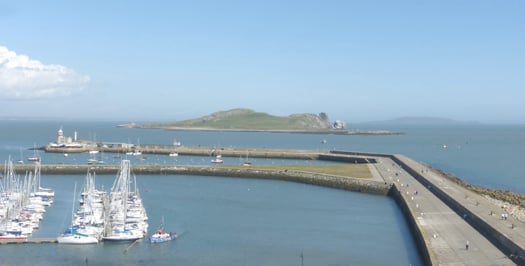
Islands of Fingal seen across the eastern part of Howth marina, with Ireland's Eye in the foreground, and Lambay beyond. Photo: W M Nixon
As for the waters they share, their most immediate neighbour is the steep island of Ireland's Eye with its pleasant southwest-facing beach, the island itself a remarkable wild nesting site, particularly when you remember that it's close beside an intensely urban setting. When a discerning visitor described Ireland's Eye as "an astonishing and perfect miniature St Kilda", he wasn't exaggerating.
Across in Malahide, where we find Fingal's other marina, Malahide YC - which recently celebrated its Golden Jubilee and currently has Graham Smith as its first second-generation Commodore – is in the curious position of having two clubhouses. One is a charming and hospitable place among trees within easy stroll of the marina, while the other is west of the long railway embankment which retains the extensive inner waters of Broadmeadow. This makes the waters into a marvellous recreational amenity and boating and sailing nursery, so not surprisingly it is home to active sailing schools. And it is also the base of Malahide YC "west", a dinghy sailing club on the Broadmeadow shore at Yellow Walls, while further west of it again is yet another club, the more recently formed Swords Sailing & Boating Club.

The map of modern Fingal shows how the southwest corner of the present region seems remote from the largely coastal and rural nature of much of the rest of the county. And it also confirms the surprise (to many) that the Phoenix Park is in Fingal.
North from Malahide, and you're into "Fingal profonde", its deeply rural nature occasionally emphasised by the sea nearby. The long Rogerstown Estuary, the next inlet after Malahide, sometimes found itself providing the northern boundary of The Pale, and as recently as the early 1800s the river at Rogerstown and the tiny port of Rush were a veritable nest of smugglers, privateers and occasionally pirates, with buccaneering captains of myth and legend such as Luke Ryan and James Mathews proving to have been real people who were pillars of society when back home in their secretive little communities after their lengthy business forays to God know where.

Muddy situation. Low water in the Rogerstown Estuary. The hill in the distance on the left is new – for years, it was the largest dump in Ireland, the Balleally Landfill. But now it is well on its way to rehabilitation as an enhancement of the landscape. Photo: W M Nixon
The Rogerstown Estuary went through an unpleasant period when its inner waters were dominated by the nearby presence of the biggest waste dump in Dublin, Balleally Landfill. It rose and rose, but now it's closed, and is in process of being revived to some sort of natural state. The result is that the vista westward from Rogerstown is much improved by a pleasant and completely new hill which so enhances the view at sunset that shrewd locals have built themselves a row of fine new houses facing west, along the quirkily named Spout Lane which runs inland from the estuary.
Whatever about the legality-pushing privateer skippers who used Rogerstown Estuary as their base in days of yore, these days it's home to the quay and storehouse which serves the ferry to Lambay, which is Fingal's only inhabited island when there are no bird wardens resident on Rockabill, and it's also the setting for another south-facing club, Rush SC. It is spiritual home these days to the historic 17ft Mermaid Class (they still occasionally build new ones in an old mill nearby), but despite the very strong tidal streams where the estuary narrows as it meets the sea, RSC also has a large cruiser fleet whose moorings are so tide-rode that unless there's a boat on the buoy, it tends to disappear under water in the final urge of the flood. This can make things distinctly interesting for strangers arriving in and hoping to borrow a mooring while avoiding getting fouled in those moorings already submerged. Not surprisingly, with their boat sizes becoming larger like everywhere else, Rush SC find that their bigger cruisers use Malahide Marina.
To seaward of Rogerstown, with the little port of Rush just round the corner, the view is dominated by Lambay. A fine big island with is own little "miniature Dun Laoghaire" to provide a harbour on its west side, it has a notable Lutyens house set among the trees. But for many years now Lambay has been a major Nature Reserve, so landing is banned, though anchorage is available in its three or four bays provided you don't interfere with the wildlife along the shore. This makes it off bounds to kayakers who might hope for a leg stretch on land, though it's still well worth paddling round close inshore.
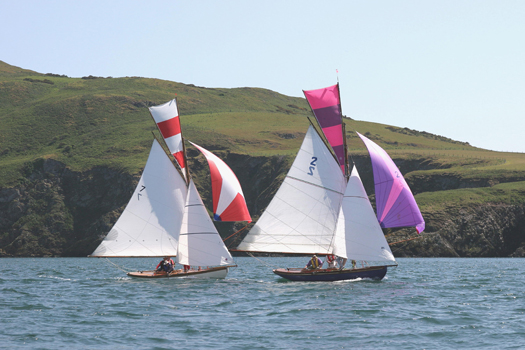
Racing round Lambay. Close competition between the Howth 17s Aura (left) and Pauline, which have been racing annually round Lambay since 1904. Photo: John Deane
Along the Fingal mainland coast, the next inlet after Rush is Loughshinny, a lovely natural harbour with a quay to further improve the bay's shelter. There's a very active little fishing fleet, while the shoreside architecture is, how shall we say, decidedly eclectic and individualistic? Go there and you'll see what I mean.
Six miles offshore, Rockabill marks the northeast limits of Fingal. It's a fine big double-rock, with a substantial lighthouse and characterful keepers' houses attached. But as it's now automated, the only time Rockabill is inhabited is for the four summer months when a bird warden or two take up residence to monitor the rocky island's most distinguished summer residents, Europe's largest breeding colony of roseate terns.
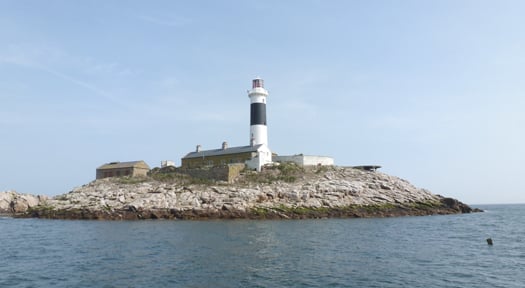
Rockabill, where the shy roseate terns feel at home. Photo: W M Nixon
In Fingal we tend to take these pretty but noisy summer visitors for granted, but the word is that south of Dublin Bay the tern buffs are so incensed by Rockabill having a clear run that they're tried to start a rival colony of roseate terns on the Muglins, and built a row of tern houses (one good tern deserves another) to facilitate their residence. The potential nest sites may not have survived the past severe winter. But in any case, one wonders if they had planning permission from Dun Laoghaire/Rathdown council for this development? Persons suggesting that such a development would almost certainly be terned down will not be given any attention whatsoever.
Skerries and Balbriggan are the two main sea towns of north Fingal, and they're as different as can be, the difference being emphasised by historic rivalry. It's said that back in the government harbour-building days of the late 19th Century a grant was made available to assist local landowners to make significant improvements to one of the harbours, and this meant war.

Balbriggan may very definitely dry out, but it provides a secure home port for both trawlers and other boats prepared to settle on the mud and sand. Photo: W M Nixon
So eventually the grant was split with half going to improve Balbriggan, and the other half to Skerries, with neither being a total success. If you seek total shelter in either today, you have to be prepared to dry out, while the anchorage off Skerries is also subject to a large tidal whorl which means that when the ebb is running in a strong onshore wind, the moorings are doubly rough and diabolically uncomfortable. And every so often after an exceptional nor'easter, we have another litany of boats driven ashore and Skerries yacht insurance going even further through the roof.
It's a situation which needs proper attention from an administration which is genuinely interested in the port. And the proper development of the harbour at Skerries, while retaining the little old place's special character, is surely something which could be much better done by Fingal Council rather than some remote Mayor of Dublin for whom Skerries will be the outermost periphery, a place seldom visited, if at all.
We've seen it all before. Time was when Fingal was simply the North County, little noticed in the centres of power which were basically Dublin City and Dublin County, their head offices in the heart of the city. But then in 2001 the new four-council setup was created, and the old name of Fingal – never forgotten by those who cherished the area – was revived. A very fine new user-friendly County Hall – it has even been praised by Frank McDonald of The Irish Times – was built in the re-born county town of Swords. Out on the new boundaries meanwhile, the signs went up saying "Welcome to Fingal County". But we old Fingallion fogeys pointed out that as Fingal means "Territory of the Fair Strangers" (i.e the Norsemen rather than the Danes), it was superfluous to be describing it as "the county of the territory", so these days it's just Fingal, and we're happy with that.
Here in Howth, we sort of slipped into acceptance of the new setup. Once upon a time, from 1917 to 1943, Howth had its own Urban District Council. It says much for the place's remoteness from the world that the HUDC was established in the midst of one global war, and quietly wound up in the midst of another. In 1943, Commissioners had to be imposed on the tiny fiefdom to offset the fact that some local interests thought the HUDC existed entirely for their own personal benefit. So at various times since, Howth was run either by Dublin County Council, or even by Dublin City Corporation. We were assured that this latter setup was all to our benefit, as the powers-that-be in City Hall had a soft spot for Howth, sure wasn't it the place where the mammy went every Thursday evening to buy the family's fish, and wouldn't she want to see it looking well?
Maybe so, but when it came to doing something more useful with the harbour, Howth Yacht Club – having re-constituted itself in 1968 from an amalgamation of Howth Sailing Club (founded 1895) and Howth Motor Yacht Club (founded 1934) - found itself dealing with a bewildering variety of government departments as the lowly interests of fishing and its ports seemed to be shifted whenever possible by civil servants who reckoned that banging the drum on behalf of fisheries in particular, and maritime interests in general, was not a shrewd career move for anyone planning a steady progress up the very landbound Irish public service ladder to the sunlit uplands of a long and prosperous retirement.
So if at times absolutely nothing seemed to be happening in a harbour which was painfully inadequate for expanding boating and fishing needs, it was partly because the club officers and fishermen's leaders could find it difficult to discern just who in authority could or would make the decisive call. In those days it turned out to be somewhere in the hidden recesses of the Office of Public Works. Suddenly, in 1979, a plan for the major re-development of the harbour was promulgated at official level, with a radical rationalisation planned for its future use. The western part, it was proposed, would become totally fisheries, while the eastern part was to be given over to recreational boating, all of it involving major civil engineering and harbour works projects.
Looking at the successful harbour today, it all seems perfectly reasonable and sensible. But back in 1979 when HYC were presented with a time-limited take-it-or-leave-it choice, the way ahead was not at all clear. Friendships were sundered and family feuds emerged from the heated progress towards accepting the offer that the club agree to vacate its premises on the West Pier - a clubhouse which it had renovated and extended only ten years earlier – and commit itself to the installation, at members' cost, of a marina in the eastern harbour with the obligation to build a completely new clubhouse there.

Today's Howth Harbour didn't happen overnight. This is how it was from 1982 until the new clubhouse was completed in 1987. Photo: W M Nixon
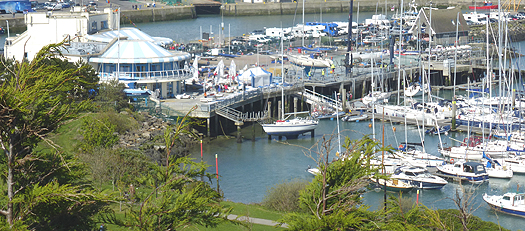
Multiple activities under way at Howth YC this week. The club's setup may seem only natural now, but it was quite a struggle to get there. Photo: W M Nixon
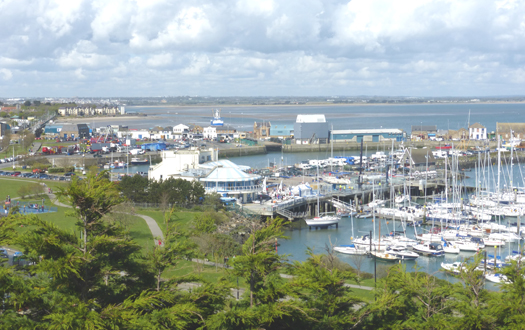
Howth's vibrant mix of a working fishing port and busy sailing centre has provided the ideal setting for the development of a successful visitor and seafood destination. Photo: W M Nixon
It's all history now, but it was done. And done so well by those involved that today it's simply taken for granted. Arguably, it's a compliment to those who created the Howth YC setup, that newer members should seldom wonder how it all came to happen, it just seems so right and natural. And as for those running the club, they in turn have to build on past achievements in dealing with an ever-changing administrative environment in which the changeover to being part of Fingal was only one of several evolutions.
Yet the recent attempt to abolish Fingal was a wake-up call. In Howth we may have wandered into it, but in just a dozen years, a dormant Fingal identity has come quietly but strongly awake. In Howth village it's natural enough, as our backs are turned to Dublin and we look to the rest of Fingal. But even on the south side of the hill, where fine houses face across Dublin Bay and you'd expect a sense of identity with households in similarly choice locations for all that they look north out of Dun Laoghaire, you find that the attraction of visiting the southside has the exotic appeal of going foreign, while those of us more humbly placed in the village, if visiting remote places like Rathmines or Terenure, find it positively unnerving to think of all the houses between us and the sea.
Then too, while Fingal Council has been establishing itself in our hearts and minds, it has been a good time for Howth Harbour. Good fences have been making good neighbours, and though marine administration in government has been kicked from pillar to post, an underlying Department of Fisheries recognition that their harbours cannot be only about fishing has led to a re-think on the use of buildings about the harbour, with Howth becoming an extraordinary nexus of good seafood restaurants, such that on a summer evening, despite the presence of a traditional fish and chip shop, the seafood aroma is of a proper fishing port in Brittany or Galicia. In fact, rents from the hospitality and sailing and marine industries in Howth have now reached such a level that fish landing fees – formerly the bedrock of the harbour economy – only contribute about 10% of the overall income.

The man from County Hall. Fingal Mayor Kieran Dennison is comfortable with his county's busy sailing activities, and the sailors are comfortable with him. He is seen here officially opening the J/24 Worlds at Howth in August 2013. Photo: W M Nixon
As for how we've been getting on with our new masters in County Hall up in Swords, the news is good. Most recently, we've been having direct contact with the current Mayor of Fingal, Kieran Dennison, who hit just the right note when he officially opened the J/24 Worlds in Howth in August 2013. Following that, he was back at the annual Commodore's Lunch in HYC in the dark days of November when a review of the past season lightens the onset of winter, and he was able to tell us that thanks to contacts made at the Worlds, his invitation to visit the America's Cup in San Francisco in September was made even more enjoyable. Those of us who reckoned the only way to visit the 34th America's Cup was on the television screen were reassured by the thought that if somebody was going to represent us in the San Francisco bear-pit, then our Mayor, our very own Mayor of Fingal, was just the man for the job.
So we very much want to keep Fingal in existence and in robust good health, but we appreciate that its current boundaries might be creating a bit of a Ukraine-versus-Russia situation. In particular, the southwest of the county could well be Fingal's Crimea and Donetsk regions. There, relatively new settlements of ethnic Dubs in places like Clonsilla, Castleknock, Blanchardstown could become such a source of trouble that it might be better to transfer them peacefully to administration by either Dublin city or South Dublin before there is unnecessary bloodshed.
The situation arises because, when the boundaries were being drawn, southwest Fingal was set out all the way down to the Liffey. The Fingallion instinct would be to see the border drawn along the Tolka, in other words the M3. But there could be trouble because of the discovery – always something of a surprise – that the Phoenix Park is in Fingal. I could see that when some people find our Fingal includes the Park, they'll want to fight for it, particularly as, in the southeast of the county, the excellent St Anne's Park in Raheny was somehow allowed to slip into Dublin City.
One thing which is definitely not for transfer is the Airport. It is naturally, utterly and totally part of Fingal. For sure, it contributes a fifth of the county's annual income from business rates, making Fingal the economically healthiest Irish county. But we in Fingal have to live with the airport very much in our midst. If Dublin really wants to take over the airport, then a first condition before negotiations even begin would be that all flight paths are to be re-routed directly over Dun Laoghaire and Dalkey. A few weeks of that would soon soften their cough.
Whatever, the recent kerfuffle about Fingal rejecting involvement in administration by an all-powerful Mayor of Dublin has been a powerful stimulant to thinking about how our own county might best be run. Everyone will have their own pet local projects, and most of us will reckon that decision-making in Swords, rather than in some vast and impenetrable office in the middle of Dublin, will be the best way to bring it about. For those of us who go afloat, the fact that Fingal Council shows that it cherishes its long and varied sea coast, rather than preferring to ignore it, is very encouraging. And the fact that this prospering county has some financial muscle all of its own gives us hope that we can build on what the past has taught us, and spread improved facilities to every port. Should that happen, it will in turn benefit Irish sailing and boating generally to a greater extent than would restricted development under one closely-controlled central administration headed by some southside megalomaniac.
Irish Yacht Clubs Lowering Fees To Attract New Members
#Sailing - Irish yacht clubs are "trying to ditch their elitist image" and cutting prices to attract a more diverse membership, according to The Sunday Times.
Members' fees across Ireland's top yacht clubs have been lowered by an average 15%, says the paper, while some clubs such as Skerries Sailing Club are experimenting with eliminating such fees altogether.
Even the world's oldest club, the Royal Cork Yacht Club, is offering an introductory rate of €180 for 2013.
While the attempt to broaden the horizons of club membership is fitting with the ISA's vision of a brighter future for Irish sailing after last year's "breakthrough year", the cutting of fees points to a different side to the story - one that puts last year's EGM on the ISA's funding structure and suggestions to radically rethink how Irish sailing spends its resources into perspective.
The Sunday Times has more on this story HERE.
Skerries Sailing Club

Overlooking scenic island-studded waters, Skerries is a vibrant and fast growing dinghy and cruiser club for adults and children. Racing (May-December) three times weekly in high season. Adult, children, newcomers to sailing and family members are especially welcomed. The bar has remarkable sea views. Slipway, car/boat park and punt service to moorings. We offer ISA Dinghy courses for children from beginners to Advanced Boat Handling and Racing 1 as well as ISA Dinghy courses for adults from beginners to Improving Skills plus Powerboat and Safetyboat courses.
SSC prides itself on its friendly atmosphere. Newcomers to sailing are warmly welcomed. A small fleet of adult and junior dinghies is available to newcomers at nominal rates to help them improve their sailing. Friendly coaching is also available. In 2008, SSC celebrated the 75th anniversary of its foundation in 1933.
In addition we are hosting three regional, national and international events for Optimists, Mirrors and Wayfarers. For details of events click the appropriate button on the left.
The affairs of Skerries Sailing Club are governed by its officers and a committee, totalling 12. The committee is chaired by a Commodore elected directly by the membership at the club's Annual General Meeting. The membership also approves the committee on an annual basis. The officers and committee are listed on the Committee page. The notice for the latest Annual General Meeting is provided on the AGM page.
Administration of the club is guided by its constitution. The text of the Constitution is available on the Constitution page of the website.
Skerries Sailing Club, Harbour Road, Skerries, Co. Dublin. Tel: +353 1 849 1233, email: [email protected]
or c/o Siobhan Boylan, Bayview, 15 Harbour Road, Skerries
Have we got your club details? Click here to get involved
























